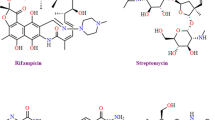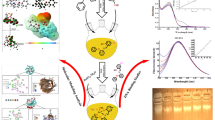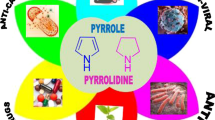Abstract
The ruthenium arene anticancer complex [(η6-bip)Ru(en)Cl][PF6] (1) (bip is biphenyl, en is ethylenediamine) reacted slowly with the amino acid L-histidine (L-His) in aqueous solution at 310 K. Two L-His adducts of 1 were separated by high-performance liquid chromatography and identified by electrospray ionisation mass spectrometry and NMR: an imidazole N δ -bound complex [(η6-bip)Ru(en)(N δ –L-His)]2+, and an N ɛ -bound complex [(η6-bip)Ru(en)(N ɛ –L-His)]2+. At 310 K, after 24 h only about 22% of complex 1 (2 mM) reacted with L-His, and of the unreacted 1, 59% had hydrolysed. In the presence of 100 mM NaCl, approximately 90% of 1 remained unreacted. In aqueous solution or triethylammonium acetate (TEAA) buffer (pH 7.6), 15N-labelled 1 reacted with cytochrome c to give two monoruthenated protein adducts. The reaction reached equilibrium within 2 h by which time approximately 50% of cytochrome c was ruthenated. On the basis of [1H, 15N] NMR data, one adduct may have Ru bound to the N-terminus, and the other to a carboxylate group on the protein. In TEAA buffer and at 310 K, more than 90% of the 14-mer oligonucleotide d(TATGTACCATGTAT) reacted with 2 mol Eq of 1 to give rise to monoruthenated and diruthenated oligonucleotide adducts. The presence of cytochrome c (1 mol Eq) or L-His (4 mol Eq) had little effect on the course of the reaction with the oligonucleotide. In cells, DNA (or RNA) may be a favoured reaction site for this Ru anticancer complex.








Similar content being viewed by others
Notes
\( K_{{\text{His}}} = {{\left[ {\left[ {\left( {\eta ^6 {\text{ - bip}}} \right){\text{Ru}}\left( {{\text{en}}} \right)\left( {{\text{L - His}}} \right)} \right]^{2 + } } \right]} \mathord{\left/ {\vphantom {{\left[ {\left[ {\left( {\eta ^6 {\text{ - bip}}} \right){\text{Ru}}\left( {{\text{en}}} \right)\left( {{\text{L - His}}} \right)} \right]^{2 + } } \right]} {\left\{ {\left[ {\left[ {\left( {\eta ^6 {\text{ - bip}}} \right){\text{Ru}}\left( {{\text{en}}} \right)\left( {{\text{H}}_{\text{2}} {\text{O}}} \right)} \right]^{2 + } } \right] \times \left[ {{\text{L - His}}} \right]} \right\}}}} \right. \kern-\nulldelimiterspace} {\left\{ {\left[ {\left[ {\left( {\eta ^6 {\text{ - bip}}} \right){\text{Ru}}\left( {{\text{en}}} \right)\left( {{\text{H}}_{\text{2}} {\text{O}}} \right)} \right]^{2 + } } \right] \times \left[ {{\text{L - His}}} \right]} \right\}}} \)
\( K_{{\text{cytc}}} = {{\left[ {\left\{ {\left( {\eta ^6 {\text{ - bip}}} \right){\text{Ru}}\left( {{\text{en}}} \right)} \right\}{\text{ - cytochrome c}}} \right]} \mathord{\left/ {\vphantom {{\left[ {\left\{ {\left( {\eta ^6 {\text{ - bip}}} \right){\text{Ru}}\left( {{\text{en}}} \right)} \right\}{\text{ - cytochrome c}}} \right]} {\left[ {\left[ {\left( {\eta ^6 {\text{ - bip}}} \right){\text{Ru}}\left( {{\text{en}}} \right)\left( {{\text{H}}_{\text{2}} {\text{O}}} \right)} \right]^{2 + } } \right] \times \left[ {{\text{cytochrome c}}} \right]}}} \right. \kern-\nulldelimiterspace} {\left[ {\left[ {\left( {\eta ^6 {\text{ - bip}}} \right){\text{Ru}}\left( {{\text{en}}} \right)\left( {{\text{H}}_{\text{2}} {\text{O}}} \right)} \right]^{2 + } } \right] \times \left[ {{\text{cytochrome c}}} \right]}} \)
The extent of ruthenation of the duplex III (formed by annealing single-strand I with its complementary strand II) showed little change after complex 1 had reacted with 2 mol Eq cytochrome c or with 8 mol Eq histidine for 6 h under the conditions used for the experiments with single-strand I (data not shown).
References
Aird RE, Cummings J, Ritchie AA, Muir M, Morris RE, Chen H, Sadler PJ, Jodrell DI (2002) Br J Cancer 86:1652–1657
Morris RE, Aird RE, Murdoch PdelS, Chen HM, Cummings J, Hughes ND, Parsons S, Parkin A, Boyd G, Jodrell DI, Sadler PJ (2001) J Med Chem 44:3616–3621
Chen HM, Parkinson JA, Parsons S, Coxall RA, Gould RO, Sadler PJ (2002) J Am Chem Soc 124:3064–3082
Chen HM, Parkinson JA, Morris RE, Sadler PJ (2003) J Am Chem Soc 125:173–186
Barnham KJ, Djuran MI, Murdoch PdelS, Ranford JD, Sadler PJ (1995) J Chem Soc Dalton Trans 3721–3726
Barnham KJ, Djuran MI, Murdoch PdelS, Ranford JD, Sadler PJ (1996) Inorg Chem 35:1065–1072
Chen Y, Guo ZJ, Murdoch PdelS, Zang EL, Sadler PJ (1998) J Chem Soc Dalton Trans 1503–1508
Barnham KJ, Djuran MI, Murdoch PdelS, Sadler PJ (1994) J Chem Soc Chem Commun 721–722
Reedijk J (1999) Chem Rev 99:2499–2510
Lempers ELM, Reedijk J (1990) Inorg Chem 29:1880–1884
Reedijk J (1992) Inorg Chim Acta 200:873–881
Wang FY, Chen HM, Parkinson JA, Murdoch PdelS, Sadler PJ (2002) Inorg Chem 41:4509–4523
Sheldrick WS, Exner R (1992) Inorg Chim Acta 195:1–9
Rogachevsky IV, Baranovski VI (2000) Spectrochim Acta A 56:2699–2705
Luo J, Wishart JF, Isied SS (1998) J Am Chem Soc 120:12970–12971
Muheim A, Todd RJ, Casimiro DR, Gray HB, Arnold FH (1993) J Am Chem Soc 115:5312–5313
McNae IW, Fishburne K, Habtemariam A, Hunter TM, Melchart M, Wang FY, Walkinshaw MD, Sadler PJ (2004) Chem Commun 1786–1787
Hwang TL, Shaka AJ (1995) J Magn Reson A 112:275–279
Palmer AG, Cavanagh J, Wright PE, Rance MJ (1991) Magn Reson 93:151–170
Kay LE, Keifer P, Saarinen T (1992) J Am Chem Soc 114:10663–10665
Schleucher J, Schwendinger M, Sattler M, Schmidt P, Schedletzky O, Glaser SJ, Sørensen OW, Griesinger C (1994) J Biomol NMR 4:301–306
Wang FY, Chen HM, Parsons S, Oswald LDH, Davidson JE, Sadler PJ (2003) Chem Eur J 9:5810–5820
Sheldrick WS, Heeb S (1989) J Organomet Chem 377:357–366
Gulka R, Isied SS (1980) Inorg Chem 19:2842–2844
Smith CA, Sutherland-Smith AJ, Keppler BK, Kratz F, Baker EN (1996) J Biol Inorg Chem 1:424–431
Kratz F, Hartmann M, Keppler B, Messori L (1994) J Biol Chem 269:2581–2588
Bushnell GW, Louie GV, Brayer GD (1990) J Mol Biol 214:585–595
Therien MJ, Selman M, Gray HB, Chang IJ, Winkler JR (1990) J Am Chem Soc 112:2420–2422
Mines GA, Bjerrum MJ, Hill MG, Casimiro DR, Chang IJ, Winkler JR, Gray HB (1996) J Am Chem Soc 118:1961–1965
Chang IJ, Lee JC, Winkler JR, Gray HB (2003) Proc Natl Acad Sci USA 100:3838–3840
Acknowledgements
We thank Edinburgh Technology Fund, Oncosense and the Wellcome Trust (support for the Edinburgh Protein Interaction Centre) for their support for this work, and Robert Smith for helpful advice on LC-MS. We are grateful to Haimei Chen for synthesising complex 1, and members of EC COST Action D20 for stimulating discussions.
Author information
Authors and Affiliations
Electronic Supplementary Material
Rights and permissions
About this article
Cite this article
Wang, F., Bella, J., Parkinson, J.A. et al. Competitive reactions of a ruthenium arene anticancer complex with histidine, cytochrome c and an oligonucleotide. J Biol Inorg Chem 10, 147–155 (2005). https://doi.org/10.1007/s00775-004-0621-5
Received:
Accepted:
Published:
Issue Date:
DOI: https://doi.org/10.1007/s00775-004-0621-5




